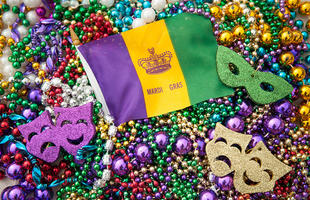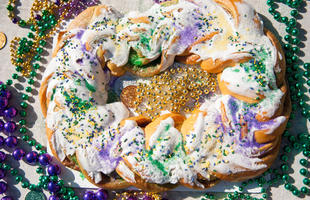
Fat Tuesday in New Orleans
Your guide to parades, traditions and planning the perfect Mardi Gras trip.
Your guide to parades, traditions and planning the perfect Mardi Gras trip.
The roots of Mardi Gras run deep throughout Louisiana, but especially in New Orleans. Learn about Carnival's history and traditions, and get tips for planning your trip to make the most of Fat Tuesday in New Orleans.
- History of Mardi Gras in New Orleans
- Can't-Miss Parades & Events
- Live Music & Second Lines
- Mardi Gras Traditions & Terms
- Planning Your Mardi Gras Trip
- Other Things to Do in New Orleans
History of Mardi Gras in New Orleans
Mardi Gras' origins can be traced to the city's French and Spanish Colonial heritage, where the celebration of Fat Tuesday marked the period of feasting and indulgence before the solemn Catholic season of Lent. Originating from the traditional "Boeuf Gras" revelry in France, Mardi Gras found its way to the colonies and, over time, transformed into the iconic festival we know today. In 1699, French-Canadian explorer Jean-Baptiste Le Moyne de Bienville christened a piece of land near New Orleans "Pointe du Mardi Gras," marking the event's emergence in the region. By the 1730s, Mardi Gras had become an integral part of New Orleans life, evolving through elegant balls and processions of maskers.
The birth of the King of Carnival, Rex, in 1872, and the establishment of Mardi Gras as a legal holiday in 1875 solidified the celebration's significance. Mardi Gras krewes, emerging from exclusive social clubs, have shaped Carnival, ensuring its continuance for generations to come.

The Krewe of Bacchus' floats give a nod to the god of wine.

Float riders have just as much fun as parade-goers!

Float designs are planned months ahead of Carnival season.

Get ready to yell "Throw me somethin'!" for some iconic throws.
Can’t-Miss Parades & Events
The days preceding Fat Tuesday are known for parades of "super krewes," krewes of more than 1,000 members riding atop larger-than-life floats. These parade routes wind through multiple neighborhoods, with the main stretch starting at Napoleon Avenue and flowing down Saint Charles Avenue, cutting through Uptown and heading to Canal Street near the French Quarter.
See the schedule of can't-miss parades below:
Saturday
- The Krewe of Iris, an all-female super krewe, rolls the Saturday morning before Mardi Gras. Known for throwing decorated sunglasses and accessories, Iris kicks off the weekend in a major way.
- The Krewe of Endymion, which rolls the Saturday night before Mardi Gras, is known for its size, light-up throws and celebrity grand marshals.
Sunday
- On Sunday, the Krewe of Bacchus rolls. Bacchus is known for its grandiose floats, sustainable and light-up throws and for bringing Hollywood flair to the city's streets with celebrity monarchs.
Monday
- The day before Mardi Gras, the Zulu King and Rex, the King of Carnival, meet along the Mississippi Riverfront and receive keys to the city as a symbol of the monarchs’ Carnival reign.
- The Krewe of Orpheus lights up the night with its extra-long floats on Monday, known as Lundi Gras.
Fat Tuesday
- On Mardi Gras Day, or Fat Tuesday, the Krewe of Zulu parade kicks off the festivities bright and early. Zulu highlights African American culture and is known for its costumes and decorated coconut throws. Catch a coconut of your own and you'll be quite popular among the crowd!
- Following Zulu, the Krewe of Rex parade rolls, starting Uptown and making its way downtown to Gallier Hall, where the King of Carnival shares a toast with the mayor of New Orleans.

Second lines are street processions led by jazz bands.

Papier-mâché flowers and decorations adorn floats.

Mardi Gras Indians are a staple of Carnival.

High school and college marching bands prepare all year for parades.
Live Music & Second Lines
To fully embrace the spirit of Mardi Gras in New Orleans, you'll want to go beyond the parades and traditional Mardi Gras tunes and experience the cultural events that showcase the city's musical and artistic heritage. Jazz music, which was born in New Orleans, takes center stage during Mardi Gras, with lively brass bands creating an atmosphere that compels even the most reserved souls to join the revelry.
Soak up live music at the iconic Preservation Hall or see who's playing at Tipitina's. From the French Quarter to Frenchmen Street, you'd be hard-pressed not to hear a local band's melodies filling the air. The city's second-line processions infuse the air with infectious rhythms and dancing, inviting everyone to join in.
Mardi Gras Traditions & Terms
Kick off Carnival on Twelfth Night with king cake, the cinnamon pastry topped in purple, green and gold sugar crystals. Inside the cake is a plastic baby figurine, and if you're lucky enough to find it, it means you're king or queen for the day — and that you have to buy the next king cake!
Mardi Gras krewes are the backbone of Carnival, social organizations that put on the parades and festivities that make up Mardi Gras. Each krewe has its own identity, complete with a theme and insignia. These groups invest months of meticulous planning, designing breathtaking floats with elaborate visual effects and decorating sought-after throws.
Parade throws are just that — items that krewe members throw off their floats to parade-goers. Throws can include beads, doubloons and trinkets, or even sustainable items like kitchen utensils, coffee beans and seasonings. Many krewes are known for their signature throws: The Krewe of Muses is known for its glittered high-heel shoes, the krewes of Endymion and Bacchus for their light-up throws, and the Krewe of Tucks for bedazzled plungers (yes, you read that right).
Also during Carnival, you might see Mardi Gras Indians, which are vibrant groups that pay homage to the city's Native American and African American roots. These tribes, known for their feathered, beaded costumes and powerful chants, offer a glimpse into the significance of Louisiana's diverse Indigenous communities.
Planning Your Mardi Gras Trip
For those eager to immerse themselves in Mardi Gras, planning is key to making the most of this extraordinary experience.
- Pack the essentials, including an easy-to-carry bag, tissues and hand sanitizer. Get our full Mardi Gras packing list.
- Get your timing right for must-see parades. Mardi Gras falls on Fat Tuesday, the day before Ash Wednesday, and parades, balls and events start about two weeks before Fat Tuesday. This period is what we call the Mardi Gras season. Make sure you know when the parade you want to see rolls.
- Book your lodging well in advance. We recommend arriving a few days before Fat Tuesday to catch some of the parades that offer a glimpse into local neighborhood celebrations. The weekend before Mardi Gras is when you can expect to see super krewes like Iris, Endymion, Bacchus and Orpheus.
- Expect crowds and pack your patience. Navigating the crowds requires a blend of patience and planning. The French Quarter, with its narrow streets and historic charm, is a go-to spot — so be prepared for throngs of fellow revelers!
- Got kids? Hit up a family-friendly spot. St. Charles Avenue in Uptown or Orleans Avenue in Mid-City both offer family-friendly atmospheres with tailgating along the parade route, food vendors, DJs and more.
- Seek out the hidden gems. These lesser-known parades often embody a more grassroots, community-driven spirit, like Krewe of Red Beans or Krewe du Vieux. These smaller parades provide an opportunity to interact with locals and experience authentic traditions.
Other Things to Do in New Orleans
No visit to New Orleans is complete without indulging in its unique culinary experiences. While beignets and po'boys are staples year-round, Mardi Gras adds its own culinary delights to the mix. King cakes dominate bakery shelves, while savory dishes like gumbo and jambalaya keep you warm during the cool evening parades.
As for can't-miss attractions, there are countless opportunities to learn about the history and customs of Mardi Gras. Check out Mardi Gras World, the Presbytère, the Backstreet Cultural Museum and the Mardi Gras Museum of Costumes and Culture, and you'll be a Mardi Gras expert in no time!


